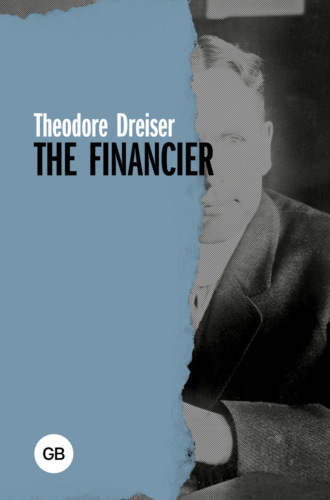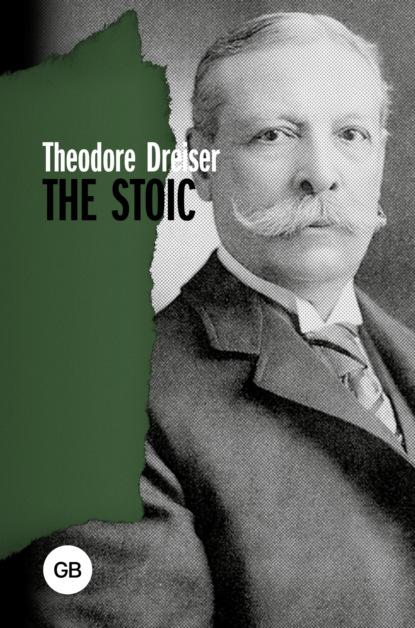
Полная версия
The Financier / Финансист
This, as one might readily see, destroyed the politicians’ little scheme to get this loan at ninety. Nevertheless since they desired that the money tied up in the old warrants and now not redeemable because of lack of funds should be paid them, the only way this could be done would be to have some broker who knew the subtleties of the stock market handle this new city loan on ’change in such a way that it would be made to seem worth one hundred and to be sold to outsiders at that figure. Afterward, if, as it was certain to do, it fell below that, the politicians could buy as much of it as they pleased, and eventually have the city redeem it at par.
George W. Stener, entering as city treasurer at this time, and bringing no special financial intelligence to the proposition, was really troubled. Henry A. Mollenhauer, one of the men who had gathered up a large amount of the old city warrants, and who now wanted his money, in order to invest it in bonanza offers in the West, called on Stener, and also on the mayor. He with Simpson and Butler made up the Big Three.
“I think something ought to be done about these warrants that are outstanding,” he explained. “I am carrying a large amount of them, and there are others. We have helped the city a long time by saying nothing; but now I think that something ought to be done. Mr. Butler and Mr. Simpson feel the same way. Couldn’t these new loan certificates be listed on the stock exchange and the money raised that way? Some clever broker could bring them to par.”
Stener was greatly flattered by the visit from Mollenhauer. Rarely did he trouble to put in a personal appearance, and then only for the weight and effect his presence would have. He called on the mayor and the president of council, much as he called on Stener, with a lofty, distant, inscrutable air. They were as office-boys to him.
In order to understand exactly the motive for Mollenhauer’s interest in Stener, and the significance of this visit and Stener’s subsequent action in regard to it, it will be necessary to scan the political horizon for some little distance back. Although George W. Stener was in a way a political henchman and appointee of Mollenhauer’s, the latter was only vaguely acquainted with him. He had seen him before; knew of him; had agreed that his name should be put on the local slate largely because he had been assured by those who were closest to him and who did his bidding that Stener was “all right,” that he would do as he was told, that he would cause no one any trouble, etc. In fact, during several previous administrations, Mollenhauer had maintained a subsurface connection with the treasury, but never so close a one as could easily be traced. He was too conspicuous a man politically and financially for that. But he was not above a plan, in which Simpson if not Butler shared, of using political and commercial stool-pigeons to bleed the city treasury as much as possible without creating a scandal. In fact, for some years previous to this, various agents had already been employed—Edward Strobik, president of council, Asa Conklin, the then incumbent of the mayor’s chair, Thomas Wycroft, alderman, Jacob Harmon, alderman, and others—to organize dummy companies under various names, whose business it was to deal in those things which the city needed—lumber, stone, steel, iron, cement—a long list—and of course, always at a fat profit to those ultimately behind the dummy companies, so organized. It saved the city the trouble of looking far and wide for honest and reasonable dealers.
Since the action of at least three of these dummies will have something to do with the development of Cowperwood’s story, they may be briefly described. Edward Strobik, the chief of them, and the one most useful to Mollenhauer, in a minor way, was a very spry person of about thirty-five at this time—lean and somewhat forceful, with black hair, black eyes, and an inordinately large black mustache. He was dapper, inclined to noticeable clothing—a pair of striped trousers, a white vest, a black cutaway coat and a high silk hat. His markedly ornamental shoes were always polished to perfection, and his immaculate appearance gave him the nickname of “The Dude” among some. Nevertheless he was quite able on a small scale, and was well liked by many.
His two closest associates, Messrs. Thomas Wycroft and Jacob Harmon, were rather less attractive and less brilliant. Jacob Harmon was a thick wit socially, but no fool financially. He was big and rather doleful to look upon, with sandy brown hair and brown eyes, but fairly intelligent, and absolutely willing to approve anything which was not too broad in its crookedness and which would afford him sufficient protection to keep him out of the clutches of the law. He was really not so cunning as dull and anxious to get along.
Thomas Wycroft, the last of this useful but minor triumvirate, was a tall, lean man, candle-waxy, hollow-eyed, gaunt of face, pathetic to look at physically, but shrewd. He was an iron-molder by trade and had gotten into politics much as Stener had—because he was useful; and he had managed to make some money—via this triumvirate of which Strobik was the ringleader, and which was engaged in various peculiar businesses which will now be indicated.
The companies which these several henchmen had organized under previous administrations, and for Mollenhauer, dealt in meat, building material, lamp-posts, highway supplies, anything you will, which the city departments or its institutions needed. A city contract once awarded was irrevocable, but certain councilmen had to be fixed in advance and it took money to do that. The company so organized need not actually slaughter any cattle or mold lamp-posts. All it had to do was to organize to do that, obtain a charter, secure a contract for supplying such material to the city from the city council (which Strobik, Harmon, and Wycroft would attend to), and then sublet this to some actual beef-slaughterer or iron-founder, who would supply the material and allow them to pocket their profit which in turn was divided or paid for to Mollenhauer and Simpson in the form of political donations to clubs or organizations. It was so easy and in a way so legitimate. The particular beef-slaughterer or iron-founder thus favored could not hope of his own ability thus to obtain a contract. Stener, or whoever was in charge of the city treasury at the time, for his services in loaning money at a low rate of interest to be used as surety for the proper performance of contract, and to aid in some instances the beef-killer or iron-founder to carry out his end, was to be allowed not only the one or two per cent. which he might pocket (other treasurers had), but a fair proportion of the profits. A complacent, confidential chief clerk who was all right would be recommended to him. It did not concern Stener that Strobik, Harmon, and Wycroft, acting for Mollenhauer, were incidentally planning to use a little of the money loaned for purposes quite outside those indicated. It was his business to loan it.
However, to be going on. Some time before he was even nominated, Stener had learned from Strobik, who, by the way, was one of his sureties as treasurer (which suretyship was against the law, as were those of Councilmen Wycroft and Harmon, the law of Pennsylvania stipulating that one political servant might not become surety for another), that those who had brought about this nomination and election would by no means ask him to do anything which was not perfectly legal, but that he must be complacent and not stand in the way of big municipal perquisites nor bite the hands that fed him. It was also made perfectly plain to him, that once he was well in office a little money for himself was to be made. As has been indicated, he had always been a poor man. He had seen all those who had dabbled in politics to any extent about him heretofore do very well financially indeed, while he pegged along as an insurance and real-estate agent. He had worked hard as a small political henchman. Other politicians were building themselves nice homes in newer portions of the city. They were going off to New York or Harrisburg or Washington on jaunting parties. They were seen in happy converse at road-houses or country hotels in season with their wives or their women favorites, and he was not, as yet, of this happy throng. Naturally now that he was promised something, he was interested and compliant. What might he not get?
When it came to this visit from Mollenhauer, with its suggestion in regard to bringing city loan to par, although it bore no obvious relation to Mollenhauer’s subsurface connection with Stener, through Strobik and the others, Stener did definitely recognize his own political subservience—his master’s stentorian voice—and immediately thereafter hurried to Strobik for information.
“Just what would you do about this?” he asked of Strobik, who knew of Mollenhauer’s visit before Stener told him, and was waiting for Stener to speak to him. “Mr. Mollenhauer talks about having this new loan listed on ’change and brought to par so that it will sell for one hundred.”
Neither Strobik, Harmon, nor Wycroft knew how the certificates of city loan, which were worth only ninety on the open market, were to be made to sell for one hundred on ’change, but Mollenhauer’s secretary, one Abner Sengstack, had suggested to Strobik that, since Butler was dealing with young Cowperwood and Mollenhauer did not care particularly for his private broker in this instance, it might be as well to try Cowperwood.
So it was that Cowperwood was called to Stener’s office. And once there, and not as yet recognizing either the hand of Mollenhauer or Simpson in this, merely looked at the peculiarly shambling, heavy-cheeked, middle-class man before him without either interest or sympathy, realizing at once that he had a financial baby to deal with. If he could act as adviser to this man—be his sole counsel for four years!
“How do you do, Mr. Stener?” he said in his soft, ingratiating voice, as the latter held out his hand. “I am glad to meet you. I have heard of you before, of course.”
Stener was long in explaining to Cowperwood just what his difficulty was. He went at it in a clumsy fashion, stumbling through the difficulties of the situation he was suffered to meet.
“The main thing, as I see it, is to make these certificates sell at par. I can issue them in any sized lots you like, and as often as you like. I want to get enough now to clear away two hundred thousand dollars’ worth of the outstanding warrants, and as much more as I can get later.”
Cowperwood felt like a physician feeling a patient’s pulse—a patient who is really not sick at all but the reassurance of whom means a fat fee. The abstrusities of the stock exchange were as his A B C’s to him. He knew if he could have this loan put in his hands—all of it, if he could have the fact kept dark that he was acting for the city, and that if Stener would allow him to buy as a “bull” for the sinking-fund while selling judiciously for a rise, he could do wonders even with a big issue. He had to have all of it, though, in order that he might have agents under him. Looming up in his mind was a scheme whereby he could make a lot of the unwary speculators about ’change go short of this stock or loan under the impression, of course, that it was scattered freely in various persons’ hands, and that they could buy as much of it as they wanted. Then they would wake to find that they could not get it; that he had it all. Only he would not risk his secret that far. Not he, oh, no. But he would drive the city loan to par and then sell. And what a fat thing for himself among others in so doing. Wisely enough he sensed that there was politics in all this—shrewder and bigger men above and behind Stener. But what of that? And how slyly and shrewdly they were sending Stener to him. It might be that his name was becoming very potent in their political world here. And what might that not mean!
“I tell you what I’d like to do, Mr. Stener,” he said, after he had listened to his explanation and asked how much of the city loan he would like to sell during the coming year. “I’ll be glad to undertake it. But I’d like to have a day or two in which to think it over.”
“Why, certainly, certainly, Mr. Cowperwood,” replied Stener, genially. “That’s all right. Take your time. If you know how it can be done, just show me when you’re ready. By the way, what do you charge?”
“Well, the stock exchange has a regular scale of charges which we brokers are compelled to observe. It’s one-fourth of one per cent. on the par value of bonds and loans. Of course, I may hav to add a lot of fictitious selling—I’ll explain that to you later—but I won’t charge you anything for that so long as it is a secret between us. I’ll give you the best service I can, Mr. Stener. You can depend on that. Let me have a day or two to think it over, though.”
He shook hands with Stener, and they parted. Cowperwood was satisfied that he was on the verge of a significant combination, and Stener that he had found someone on whom he could lean.
Chapter XV
The plan Cowperwood developed after a few days’ meditation will be plain enough to any one who knows anything of commercial and financial manipulation, but a dark secret to those who do not. In the first place, the city treasurer was to use his (Cowperwood’s) office as a bank of deposit. He was to turn over to him, actually, or set over to his credit on the city’s books, subject to his order, certain amounts of city loans—two hundred thousand dollars at first, since that was the amount it was desired to raise quickly—and he would then go into the market and see what could be done to have it brought to par. The city treasurer was to ask leave of the stock exchange at once to have it listed as a security. Cowperwood would then use his influence to have this application acted upon quickly. Stener was then to dispose of all city loan certificates through him, and him only. He was to allow him to buy for the sinking-fund, supposedly, such amounts as he might have to buy in order to keep the price up to par. To do this, once a considerable number of the loan certificates had been unloaded on the public, it might be necessary to buy back a great deal. However, these would be sold again. The law concerning selling only at par would have to be abrogated to this extent—i.e., that the wash sales and preliminary sales would have to be considered no sales until par was reached.
There was a subtle advantage here, as Cowperwood pointed out to Stener. In the first place, since the certificates were going ultimately to reach par anyway, there was no objection to Stener or any one else buying low at the opening price and holding for a rise. Cowperwood would be glad to carry him on his books for any amount, and he would settle at the end of each month. He would not be asked to buy the certificates outright. He could be carried on the books for a certain reasonable margin, say ten points. The money was as good as made for Stener now. In the next place, in buying for the sinking-fund it would be possible to buy these certificates very cheap, for, having the new and reserve issue entirely in his hands, Cowperwood could throw such amounts as he wished into the market at such times as he wished to buy, and consequently depress the market. Then he could buy, and, later, up would go the price. Having the issues totally in his hands to boost or depress the market as he wished, there was no reason why the city should not ultimately get par for all its issues, and at the same time considerable money be made out of the manufactured fluctuations. He, Cowperwood, would be glad to make most of his profit that way. The city should allow him his normal percentage on all his actual sales of certificates for the city at par (he would have to have that in order to keep straight with the stock exchange); but beyond that, and for all the other necessary manipulative sales, of which there would be many, he would depend on his knowledge of the stock market to reimburse him. And if Stener wanted to speculate with him—well.
Dark as this transaction may seem to the uninitiated, it will appear quite clear to those who know. Manipulative tricks have always been worked in connection with stocks of which one man or one set of men has had complete control. It was no different from what subsequently was done with Erie, Standard Oil, Copper, Sugar, Wheat, and what not. Cowperwood was one of the first and one of the youngest to see how it could be done. When he first talked to Stener he was twenty-eight years of age. When he last did business with him he was thirty-four.
The houses and the bank-front of Cowperwood & Co. had been proceeding apace. The latter was early Florentine in its decorations with windows which grew narrower as they approached the roof, and a door of wrought iron set between delicately carved posts, and a straight lintel of brownstone. It was low in height and distinguished in appearance. In the center panel had been hammered a hand, delicately wrought, thin and artistic, holding aloft a flaming brand. Ellsworth informed him that this had formerly been a money-changer’s sign used in old Venice, the significance of which had long been forgotten.
The interior was finished in highly-polished hardwood, stained in imitation of the gray lichens which infest trees. Large sheets of clear, beveled glass were used, some oval, some oblong, some square, and some circular, following a given theory of eye movement. The fixtures for the gas-jets were modeled after the early Roman flame-brackets, and the office safe was made an ornament, raised on a marble platform at the back of the office and lacquered a silver-gray, with Cowperwood & Co. lettered on it in gold. One had a sense of reserve and taste pervading the place, and yet it was also inestimably prosperous, solid and assuring. Cowperwood, when he viewed it at its completion, complimented Ellsworth cheerily. “I like this. It is really beautiful. It will be a pleasure to work here. If those houses are going to be anything like this, they will be perfect.”
“Wait till you see them. I think you will be pleased, Mr. Cowperwood. I am taking especial pains with yours because it is smaller. It is really easier to treat your father’s. But yours—” He went off into a description of the entrance-hall, reception-room and parlor, which he was arranging and decorating in such a way as to give an effect of size and dignity not really conformable to the actual space.
And when the houses were finished, they were effective and arresting—quite different from the conventional residences of the street. They were separated by a space of twenty feet, laid out as greensward. The architect had borrowed somewhat from the Tudor school, yet not so elaborated as later became the style in many of the residences in Philadelphia and elsewhere. The most striking features were rather deep-recessed doorways under wide, low, slightly floriated arches, and three projecting windows of rich form, one on the second floor of Frank’s house, two on the facade of his father’s. There were six gables showing on the front of the two houses, two on Frank’s and four on his father’s. In the front of each house on the ground floor was a recessed window unconnected with the recessed doorways, formed by setting the inner external wall back from the outer face of the building. This window looked out through an arched opening to the street, and was protected by a dwarf parapet or balustrade. It was possible to set potted vines and flowers there, which was later done, giving a pleasant sense of greenery from the street, and to place a few chairs there, which were reached via heavily barred French casements.
On the ground floor of each house was placed a conservatory of flowers, facing each other, and in the yard, which was jointly used, a pool of white marble eight feet in diameter, with a marble Cupid upon which jets of water played. The yard which was enclosed by a high but pierced wall of green-gray brick, especially burnt for the purpose the same color as the granite of the house, and surmounted by a white marble coping which was sown to grass and had a lovely, smooth, velvety appearance. The two houses, as originally planned, were connected by a low, green-columned pergola which could be enclosed in glass in winter.
The rooms, which were now slowly being decorated and furnished in period styles were very significant in that they enlarged and strengthened Frank Cowperwood’s idea of the world of art in general. It was an enlightening and agreeable experience—one which made for artistic and intellectual growth—to hear Ellsworth explain at length the styles and types of architecture and furniture, the nature of woods and ornaments employed, the qualities and peculiarities of hangings, draperies, furniture panels, and door coverings. Ellsworth was a student of decoration as well as of architecture, and interested in the artistic taste of the American people, which he fancied would some day have a splendid outcome. He was wearied to death of the prevalent Romanesque composite combinations of country and suburban villa. The time was ripe for something new. He scarcely knew what it would be; but this that he had designed for Cowperwood and his father was at least different, as he said, while at the same time being reserved, simple, and pleasing. It was in marked contrast to the rest of the architecture of the street. Cowperwood’s dining-room, reception-room, conservatory, and butler’s pantry he had put on the first floor, together with the general entry-hall, staircase, and coat-room under the stairs. For the second floor he had reserved the library, general living-room, parlor, and a small office for Cowperwood, together with a boudoir for Lillian, connected with a dressing-room and bath.
On the third floor, neatly divided and accommodated with baths and dressing-rooms, were the nursery, the servants’ quarters, and several guest-chambers.
Ellsworth showed Cowperwood books of designs containing furniture, hangings, etageres, cabinets, pedestals, and some exquisite piano forms. He discussed woods with him—rosewood, mahogany, walnut, English oak, bird’s-eye maple, and the manufactured effects such as ormolu, marquetry, and Boule, or buhl. He explained the latter—how difficult it was to produce, how unsuitable it was in some respects for this climate, the brass and tortoise-shell inlay coming to swell with the heat or damp, and so bulging or breaking. He told of the difficulties and disadvantages of certain finishes, but finally recommended ormolu furniture for the reception room, medallion tapestry for the parlor, French renaissance for the dining-room and library, and bird’s-eye maple (dyed blue in one instance, and left its natural color in another) and a rather lightly constructed and daintily carved walnut for the other rooms. The hangings, wall-paper, and floor coverings were to harmonize—not match—and the piano and music-cabinet for the parlor, as well as the etagere, cabinets, and pedestals for the reception-rooms, were to be of buhl or marquetry, if Frank cared to stand the expense.
Ellsworth advised a triangular piano—the square shapes were so inexpressibly wearisome to the initiated. Cowperwood listened fascinated. He foresaw a home which would be chaste, soothing, and delightful to look upon. If he hung pictures, gilt frames were to be the setting, large and deep; and if he wished a picture-gallery, the library could be converted into that, and the general living-room, which lay between the library and the parlor on the second-floor, could be turned into a combination library and living-room. This was eventually done; but not until his taste for pictures had considerably advanced.
It was now that he began to take a keen interest in objects of art, pictures, bronzes, little carvings and figurines, for his cabinets, pedestals, tables, and etageres. Philadelphia did not offer much that was distinguished in this realm—certainly not in the open market. There were many private houses which were enriched by travel; but his connection with the best families was as yet small. There were then two famous American sculptors, Powers and Hosmer, of whose work he had examples; but Ellsworth told him that they were not the last word in sculpture and that he should look into the merits of the ancients. He finally secured a head of David, by Thorwaldsen, which delighted him, and some landscapes by Hunt, Sully, and Hart, which seemed somewhat in the spirit of his new world.
The effect of a house of this character on its owner is unmistakable. We think we are individual, separate, above houses and material objects generally; but there is a subtle connection which makes them reflect us quite as much as we reflect them. They lend dignity, subtlety, force, each to the other, and what beauty, or lack of it, there is, is shot back and forth from one to the other as a shuttle in a loom, weaving, weaving. Cut the thread, separate a man from that which is rightfully his own, characteristic of him, and you have a peculiar figure, half success, half failure, much as a spider without its web, which will never be its whole self again until all its dignities and emoluments are restored.










